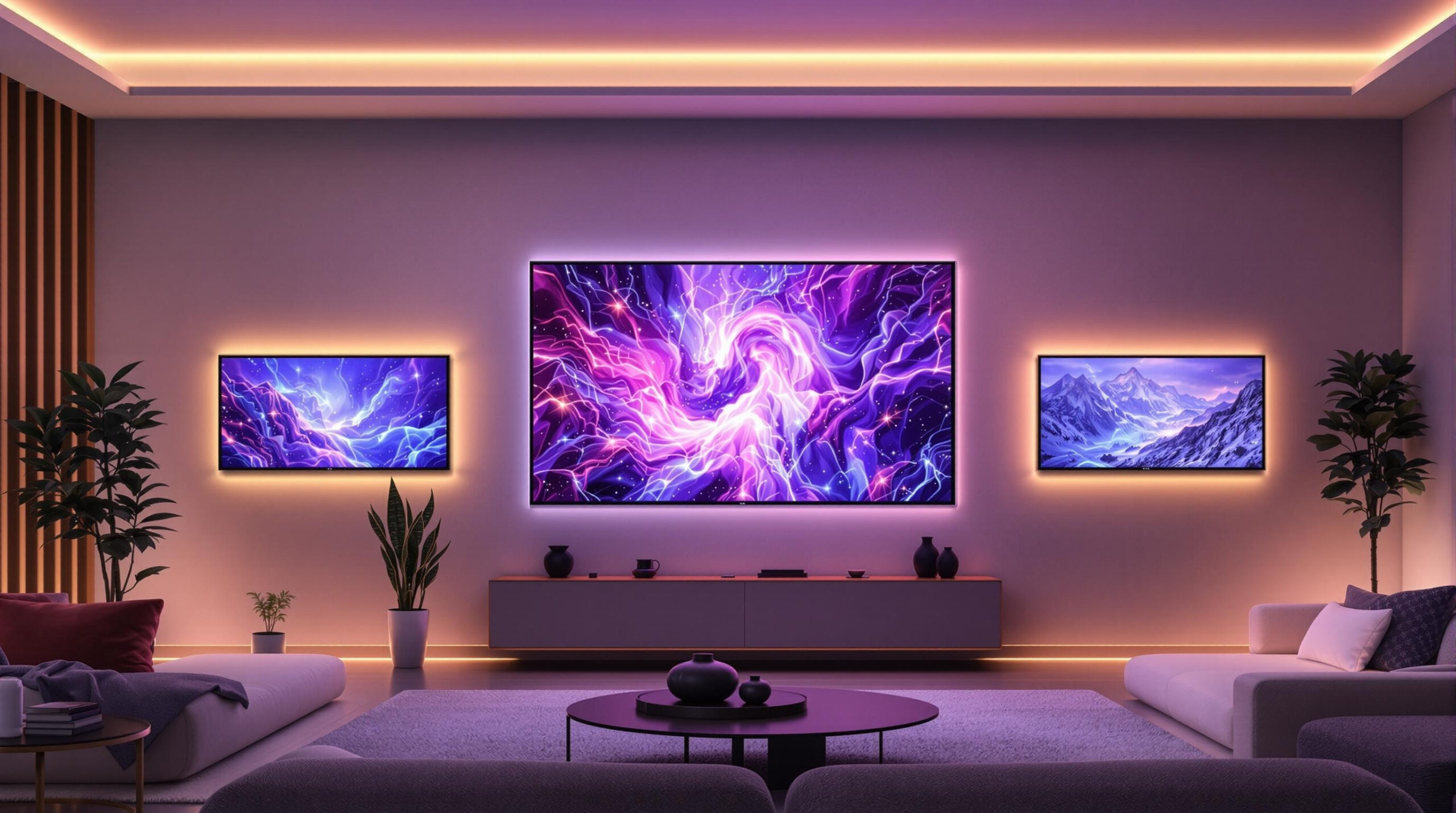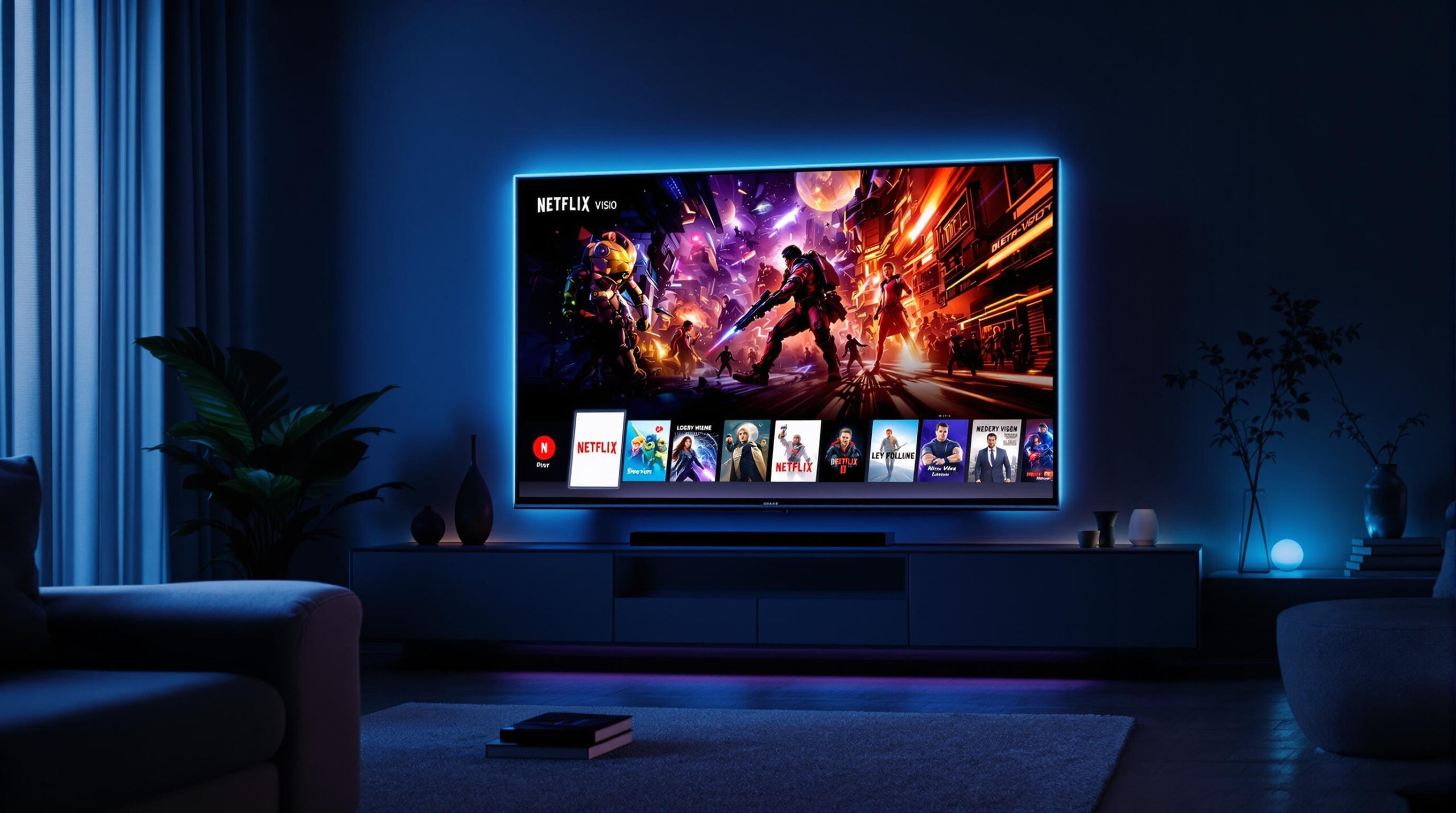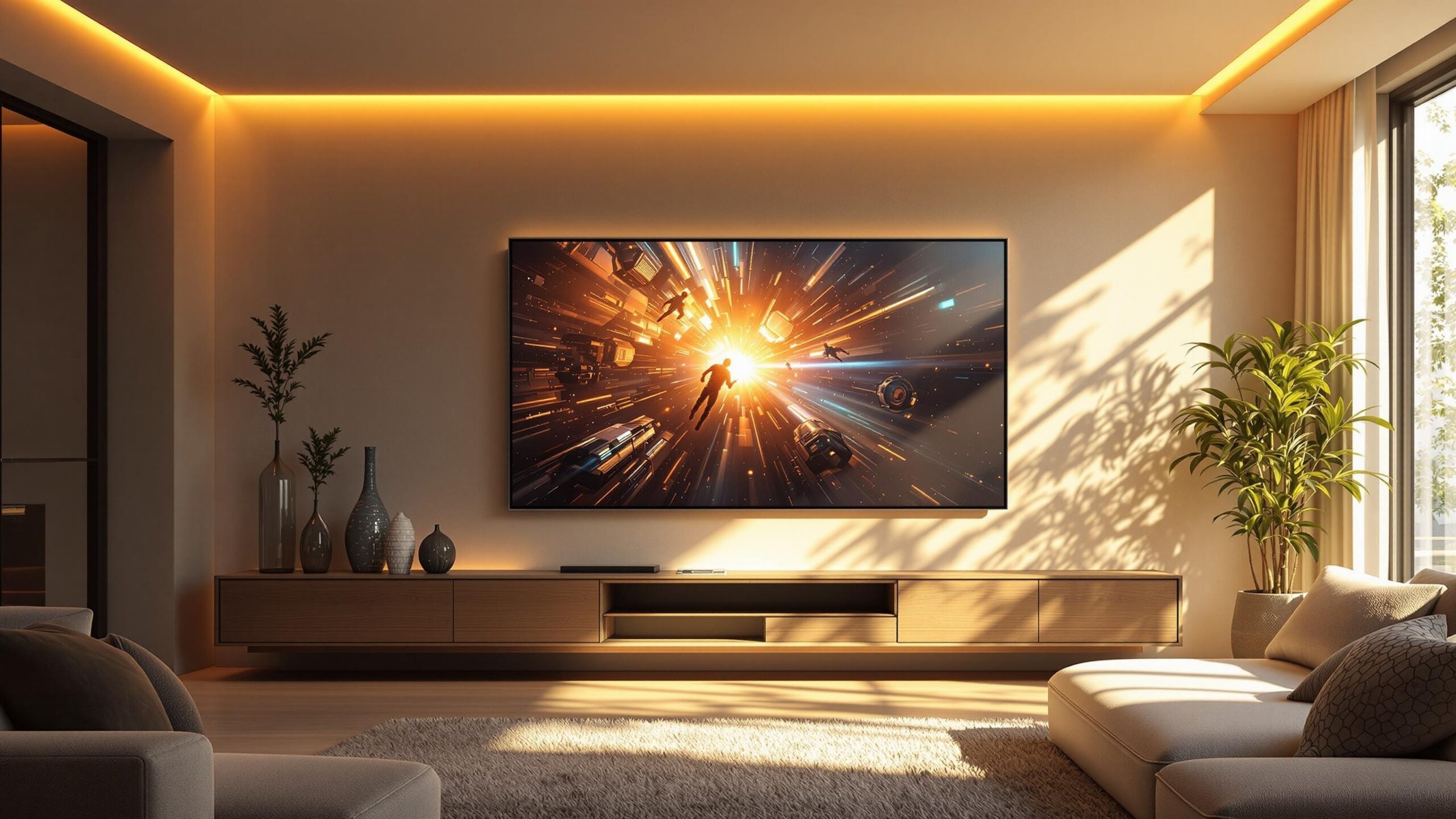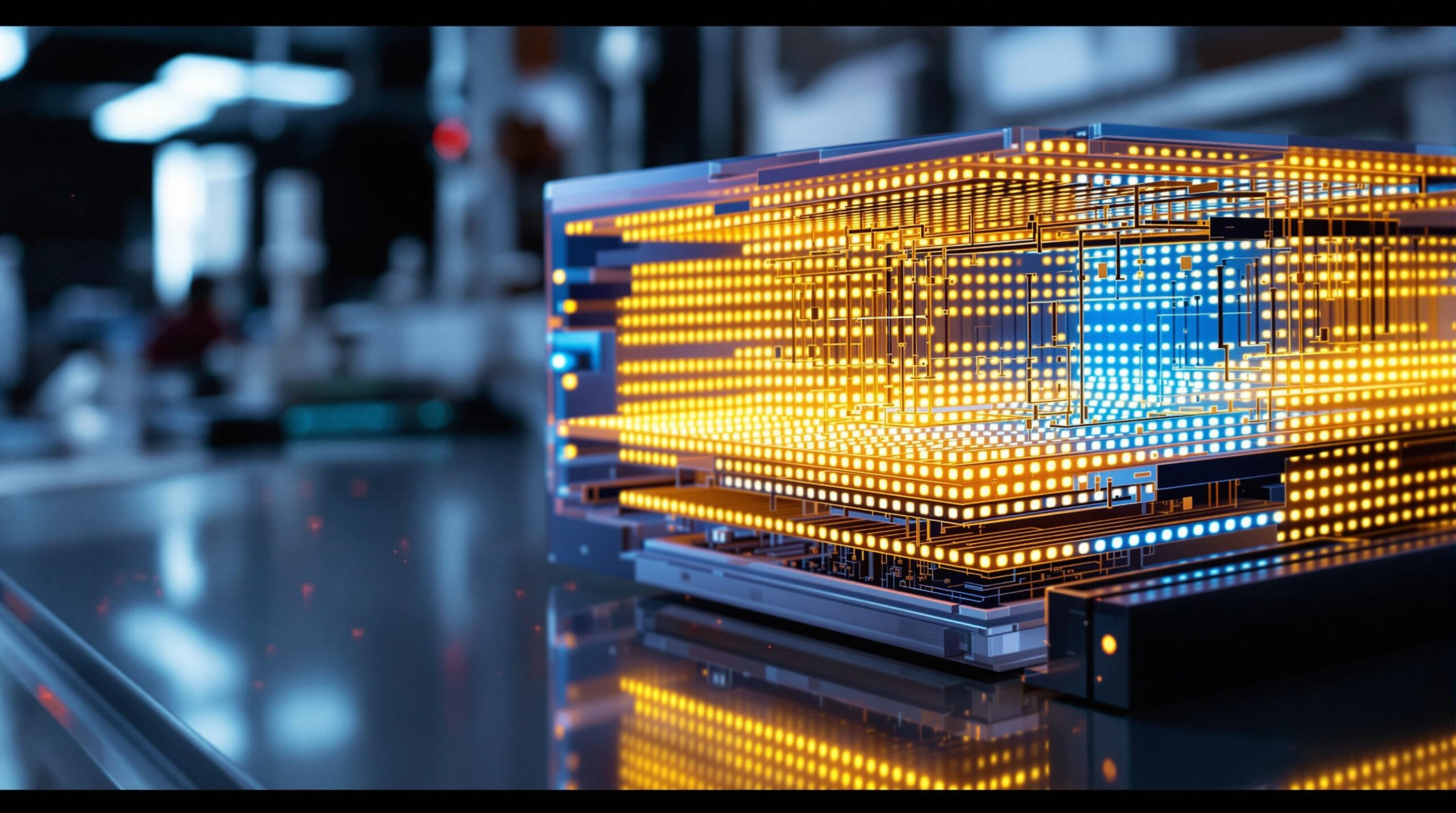The world of LED/LCD televisions has undergone a renaissance in the past few model years, fueled by the rapid maturation of Mini-LED backlighting, ever-more sophisticated local-dimming algorithms, and quantum-dot color layers that rival OLED in vibrancy—yet sustain far greater brightness. If you prize dazzling HDR highlights, daylight-proof screen luminance, and long-term image-retention safety, a flagship LED/LCD remains the king of real-world versatility. To craft the following ranking, I evaluated picture quality (contrast control, color accuracy, peak brightness), gaming performance (refresh rate, VRR range, input lag), smart-platform polish, build quality, audio, value, and each model’s design story. Every entry earns its spot not just by excelling at one metric but by offering a compelling blend of engineering, history, and user experience. Screen sizes vary—55-inch to 85-inch configurations dominate—but all measurements are listed in inches so you can gauge cabinet fit without mental math. Buckle up for a coast-to-coast tour of the ten LED/LCD sets that do 2024–2025 television engineering proud.
#1: Gold Award: Samsung QN90D Neo QLED ($$)
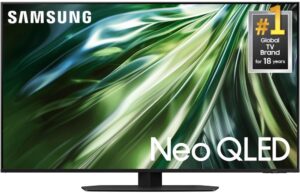
Samsung’s QN90D represents the pinnacle of LED/LCD television engineering in 2025, a flagship model that pushes the boundaries of what backlit panel technology can achieve. Anchored by the fourth-generation Neo QLED architecture, it leverages over 1,300 independently controlled Mini-LEDs—each smaller than the width of a human hair—placed behind Samsung’s Quantum Matrix lens system to achieve elite local dimming performance. This combination allows the QN90D to deliver jaw-dropping specular highlights of over 2,200 nits while preserving inky blacks with minimal blooming. In scenes with deep shadows and piercing brightness—such as fireworks or torch-lit caverns—it delivers a dynamic range that feels closer to OLED than ever before. Its 14-bit luminance mapping algorithm allows the panel to articulate over 16,000 steps of brightness gradation, ensuring smooth transitions from black to white that eliminate the banding and stepping seen in 10-bit panels. It’s a TV that doesn’t just display detail—it carves it out with surgical precision. The brains behind the visual spectacle is Samsung’s NQ8 Gen 2 AI processor, which harnesses a 512-neuron deep-learning network trained on nearly two decades of broadcast, film, and HDR content. This chip executes real-time object-based upscaling, noise reduction, and color tone rebalancing, allowing 1080p content to look indistinguishable from native 4K—without added sharpness artifacts or digital haloing. Whether you’re watching classic DVDs, low-bitrate streams, or pristine UHD Blu-rays, the image is uniformly clean and crisp. The panel itself is also capable of native 144 Hz refresh, supported on all four HDMI 2.1 ports, making it one of the few TVs that delivers true high frame rate performance across multiple sources simultaneously. VRR support spans 48 Hz to 144 Hz, with FreeSync Premium Pro certification, making it an elite choice for gamers on PC, Xbox Series X, or Play Station 5.
Audio is equally impressive. With a 40-watt 2.2.2 speaker system and Dolby Atmos virtualization, dialog is center-anchored and soundtracks expand with real depth. The built-in subwoofers give explosions a respectable thump, while the object tracking system simulates overhead movement impressively for an all-in-one unit. Tizen OS has also been completely redesigned: instead of cluttered app grids, users now navigate through genre-specific hubs featuring visual poster tiles that load almost instantly. Samsung’s integration of smart home controls and voice assistants now spans Bixby, Alexa, and Google Assistant, and the new solar-powered remote never needs a battery change. There are caveats—Samsung still refuses to support Dolby Vision, limiting compatibility with some Netflix and UHD disc content. And while blooming is tamed better than ever, it can still appear in highly exaggerated test clips. Still, these drawbacks are far outweighed by the raw display firepower.
In terms of design and sustainability, the QN90D continues Samsung’s green shift. The chassis incorporates recycled aluminum and ocean-bound plastics, and its flush-mount bracket allows the screen to hang like artwork with less than a one-inch wall gap. The lineage of the QN90 series dates back to the Q90R in 2019, Samsung’s first serious attempt to dethrone Sony’s Z9D. With the QN90D, they’ve arguably done just that. Whether you’re watching HDR blockbusters, streaming a YouTube vlog in daylight, or competing in a 144 Hz tournament match, this TV adapts and excels in every scenario. It’s not just the best LED/LCD Samsung has ever built—it’s one of the most versatile home displays available at any price.
330+ user ratings with an average of 4.3
#2: Silver Award: TCL QM8 QLED 4K TV (2024)($$)
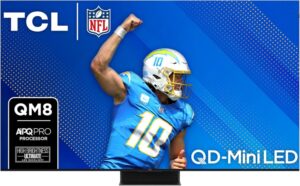
The Sony Bravia XR X90L may be a step down from the X95L on paper, but in execution, it offers extraordinary performance and exceptional value. This model trades Mini-LED backlighting for a more traditional full-array LED system, but it compensates with meticulous engineering and class-leading picture processing. With about 100 local dimming zones on the 65-inch variant, the X90L achieves surprisingly deep blacks, strong contrast, and peak brightness levels in the 1,300 to 1,400 nit range for HDR content. While that may not hit the dazzling peaks of its Mini-LED sibling, it still comfortably surpasses most LED/LCD TVs in its price bracket.
The same Cognitive Processor XR that powers the X95L is present here, ensuring detailed image analysis and adaptive contrast management. The processor enhances clarity in fast-moving scenes, sharpens low-resolution content, and dynamically optimizes skin tones, cloud gradients, and nighttime shadows in a way that feels both subtle and cinematic. The Triluminos Pro color system delivers a near-complete DCI-P3 color space without relying on quantum-dot enhancement, thanks to Sony’s tuned phosphor backlighting and precise signal mapping.
Motion performance is another area where the X90L shines. Sony’s XR Motion Clarity uses fast panel response times and frame interpolation to reduce motion blur without introducing soap opera effects. Whether you’re watching fast-paced sports, high-octane action movies, or 60 fps gaming footage, motion artifacts are kept impressively low. The 120Hz native panel also supports VRR and ALLM via two HDMI 2.1 ports, making it well-suited for PlayStation 5, Xbox Series X, or modern gaming PCs. Input lag is competitive at under 10ms, and the Game Menu includes an FPS meter and quick settings toggles.
The X90L supports a full suite of HDR formats—Dolby Vision, HDR10, and HLG—ensuring compatibility with all major streaming services and 4K Blu-ray titles. Audio is handled by Sony’s X-Balanced Speaker array, which includes side-firing drivers that enhance stereo separation and deliver clear dialog even at lower volumes. While the audio doesn’t match the spatial dynamics of the X95L’s top-mounted tweeters, it’s still far better than average for TVs in this segment.
Design-wise, the X90L carries Sony’s clean, minimalist aesthetic with a narrow bezel and a low-profile central pedestal stand. It’s wall-mountable with standard VESA compatibility and features cable management to keep your setup tidy. Smart features run on Google TV, with access to thousands of apps, content recommendations, and integration with Google Assistant, Alexa, and Apple AirPlay. Sony’s commitment to eco-friendliness is also evident here, with partially recycled materials and reduced packaging bulk.
The X90L traces its roots to the legendary X900F and X900H models, which set new benchmarks for midrange LED/LCD performance in the late 2010s. Sony has continued to refine the formula over the years, enhancing processing power, expanding color range, and improving black levels—culminating in the XR X90L, which offers nearly flagship-grade performance at a more accessible price. For viewers who want premium Sony quality, excellent HDR, and top-tier gaming performance without stepping into Mini-LED pricing, the X90L is a clear standout.
260+ user ratings with an average of 4.3
#3: Bronze Award: Sony Bravia XR X95L Mini-LED 4K TV (Expanded Version) ($$$$)

The Sony Bravia XR X95L isn’t just another Mini-LED television—it’s a masterstroke of motion and contrast processing tailored for true cinematic fidelity. At first glance, it may not chase sheer brightness crown jewels like Samsung’s QN90D or TCL’s QM8, but where it absolutely dominates is in its surgical contrast shaping and the uncanny realism that results. Sony’s Cognitive Processor XR doesn’t simply enhance brightness or color—it interprets spatial layout the way the human brain does. By understanding scene depth—foreground, midground, and background—this processor adjusts luminance, shadow detail, and tone mapping independently across those layers. The result? Shadowed cheekbones, glinting reflections on water, and subtle gradations in smoke or mist are preserved with a level of nuance that even high-end OLEDs occasionally miss. At 1,800 nits of peak brightness, the X95L can still deliver HDR highlights that sizzle, but its real secret lies in how restraint is used just as artfully as power.
This model’s screen technology amplifies its processing excellence. With Sony’s X-Anti-Reflection panel coating and X-Wide Angle optical layer, the screen maintains color fidelity and contrast even when you’re seated at off-center viewing positions, making it ideal for wide living rooms or family setups. Full-array local dimming works in tandem with Sony’s XR Backlight Master Drive—a custom control algorithm that enables the LED clusters to dim or brighten in more nuanced steps than traditional zone controls. You won’t see harsh blooming, halo artifacts, or color clipping. Blacks stay deep. Whites stay crisp. Colors look perfectly balanced, even in tough content like snowy landscapes at night.
For gamers, the X95L is a precision instrument. With two HDMI 2.1 ports supporting 4K at 120 Hz, VRR, and ALLM, it’s tailored for PlayStation 5 performance—including exclusive Auto HDR Tone Mapping and Game Menu features. While some may wish for four full-bandwidth HDMI 2.1 ports, the inclusion of these key features—along with under-10 ms latency—makes it more than competent. Sony has also rolled out a new Game Menu overlay where players can monitor FPS, enable black equalizer functions, and quickly toggle motion smoothing—all in-game, without diving through deep menus.
Audio is another standout. Sony’s Acoustic Multi-Audio+ system places tweeters around the perimeter of the screen, giving the illusion that dialogue and effects originate from their exact location in the frame. A dedicated subwoofer adds punch, and the TV even supports 360 Spatial Sound Mapping when paired with a Sony home theater system. As for smart features, the X95L runs Google TV with effortless fluency, giving users access to personalized content hubs, streaming apps, and hands-free Assistant voice commands. It also supports AirPlay 2 and Chromecast built-in, making it a hub for both Apple and Android households.
In terms of design, the chassis is beautifully minimal. Sony took inspiration from its BVM professional monitors to reinforce the frame’s structural rigidity without adding thickness—this 85-inch model mounts flush to a standard wall stud layout. Environmentally, Sony continues its initiative to reduce virgin plastic use, and the packaging is 90% recyclable. Historically, the X95 lineage traces back to Sony’s legendary Z9D competition series, and each model since has been defined by elegant software/hardware synergy rather than raw power alone. For those who prioritize filmmaker intent, impeccable shadow control, and color integrity over raw nit counts, the Sony Bravia XR X95L is the most refined LED/LCD TV in the world.
#4: Hisense U8N ULED Mini-LED 4K TV (Expanded Version)($$)

The Hisense U8N may be the most aggressive bang-for-buck TV of 2025—a Mini-LED monster that fuses staggering brightness, bold color output, and gaming-centric features, all without burning a hole in your budget. With nearly 1,600 individual dimming zones and a full-array Mini-LED structure that rivals more expensive Samsung and Sony models, the U8N delivers contrast performance that’s miles ahead of what its mid-range pricing suggests. At its core is the Hi-View Engine Pro, a real-time processing suite that continuously adjusts local dimming, peak brightness, and tone mapping across thousands of mini zones. It’s designed not only to push HDR into the stratosphere (peaking at 1,900 nits) but also to preserve shadow detail and limit blooming in challenging scenes. Hisense’s algorithmic management of LED transitions is so fast that dark-to-light shifts happen with virtually no ghosting or banding.
Quantum Dot layering further enhances the display’s color capabilities, achieving 97% DCI-P3 coverage and exceeding 80% Rec. 2020—the mark of a premium wide-color-gamut display. The panel supports native 144 Hz refresh rates, offering extraordinary motion clarity for sports and next-gen console games. Game Mode Pro lowers latency to below 10 ms and offers features like VRR, ALLM, and FreeSync Premium. Hisense even includes a dedicated Game Bar menu, where players can tweak responsiveness, shadow visibility, and refresh behavior in real-time. If you’re building a PC-centric gaming setup or are a competitive FPS player, the U8N performs like a panel costing twice as much.
On the software side, Hisense has wisely chosen Google TV—offering lightning-quick navigation, tailored content suggestions, and app compatibility that rivals the best from Sony or TCL. Voice integration is seamless, and profile-based content curation means everyone in your household gets a personalized experience. Dolby Vision IQ and HDR10+ Adaptive ensure HDR tone-mapping is intelligently adjusted to match your room’s ambient light using the U8N’s built-in sensors. No need to fumble with brightness sliders—this TV adapts automatically whether it’s daylight or late-night binging.
Design-wise, the U8N stands out. The chassis is under 1.5 inches thick, hiding an internal graphite thermal sheet that improves LED efficiency and keeps the panel running cooler than past Hisense generations. The bezels are razor-thin and anodized with a midnight finish to reduce edge reflections. The remote includes a glow feature that activates on touch, making late-night navigation easier. And the TV ships with a two-height stand that lets you raise the set just enough to accommodate a center-channel soundbar—clever thinking in a price class that often skips such conveniences.
Hisense has also taken small but significant steps toward sustainability: the circuit boards in the U8N use plant-based solder masks, reducing volatile organic compound emissions during production. The lineage of the U8 series began as a Canada-only test model in 2018, expanded to global release by 2020, and has now solidified its place among top-tier LED/LCDs. Each new generation has more than doubled dimming zones and refined processing response time. The U8N doesn’t just catch up to premium competitors—it sometimes passes them in outright brightness, color punch, and gamer responsiveness. If you want maximum performance with minimum compromise and refuse to overpay for prestige branding, the U8N is your new secret weapon.
30+ user ratings with an average of 4.4
#5: Samsung Q80D QLED 4K TV (Expanded Version) ($$$)
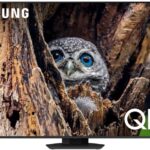
Occupying the sweet spot in Samsung’s 2024 lineup, the Q80D QLED 4K TV is a thoughtfully designed balance between high-end performance and reasonable pricing. It’s not a Neo QLED—meaning no Mini-LED backlighting—but it still delivers a premium experience through full-array local dimming with approximately 1,000 dimming zones. This allows the Q80D to hit a credible 1,300 nits of peak brightness while maintaining contrast levels that exceed most non-Mini-LED competitors. It’s the kind of TV that still delivers punchy HDR content, especially in dark rooms, without the price tag that accompanies Samsung’s flagship QN90D or QN95D models. In terms of performance-to-cost ratio, it’s arguably Samsung’s most competitive offering this year.
The panel runs natively at 120 Hz and supports FreeSync Premium Pro, ALLM, and VRR—so it’s more than ready for gaming on both consoles and PC. With input lag in the low 10ms range and a response time that matches many higher-tier models, it’s ideal for sports, racing games, and FPS titles. The fourth-generation Quantum Processor 4K brings some clever AI-based upscaling and noise reduction capabilities to the table, which is especially useful for standard-definition cable broadcasts or older Blu-rays. It uses scene analysis and database matching to clean up artifacts without over-sharpening, resulting in a more natural image.
Audio receives a notable upgrade too: six internal speakers, arranged in a 2.2.2 configuration, use Samsung’s Object Tracking Sound Lite system to steer effects toward the part of the screen where they occur—whether it’s a helicopter zipping overhead or footsteps creeping from behind. While it can’t replicate full Atmos from above, it gets impressively close in a mid-sized room, and for most users, an external soundbar won’t feel like a necessity. The design is sleek, with a centrally mounted pedestal that’s compact enough to fit smaller consoles and includes concealed cable routing. It’s also wall-mountable with a relatively slim profile, even if it’s not quite flush like Samsung’s ultra-thin models.
The Q80D runs Tizen OS, which has undergone a smart redesign to simplify access to recent apps and sources. Gone are the old multi-tile cluttered pages; in their place are genre hubs with thumbnail previews that are more visually engaging and much faster to load. Samsung Smart Hub also incorporates multi-view, smart home controls, and profile personalization. Like its siblings, the Q80D omits Dolby Vision, which might be a letdown for purists who consume a lot of streaming content in that format. Still, HDR10+ support softens the blow, and the vast majority of users won’t notice the difference outside of direct side-by-side comparisons.
Historically, the Q80 series launched in 2017 alongside Samsung’s first QLEDs and has remained the company’s workhorse model—offering near-flagship performance at attainable pricing. The 2024 Q80D iteration continues that tradition, updating its processor, local dimming algorithms, and smart platform polish. Its construction even uses 40% more recycled aluminum than its predecessor and shaves two pounds off the total weight without losing rigidity. If you’re looking for Samsung’s signature Quantum Dot color science, fast gaming features, and respectable HDR impact without the cost of cutting-edge Mini-LED, the Q80D is your best bet.
280+ user ratings with an average of 4.3
#6: TCL Q7 QLED 4K TV (2024) ($$)

The TCL Q7 is an excellent example of how far value-driven brands have come in offering premium features at a reasonable price. Positioned just below TCL’s flagship QM8, the Q7 offers an impressive combination of QLED technology, Full Array Local Dimming, and a native 120Hz refresh rate—making it a serious competitor in the mid-tier LED/LCD space. It delivers rich colors, solid contrast performance, and smooth motion handling, all enhanced by TCL’s High Brightness Pro backlight system and over 200 local dimming zones. This results in excellent peak brightness for HDR content, deeper blacks than expected at this price point, and vivid color reproduction with wide color gamut support.
The TV supports Dolby Vision IQ, HDR10+, HLG, and standard HDR10 formats, and its support for the major standards ensures cinematic content is displayed exactly as intended. The Q7 also shines for gamers, thanks to Game Accelerator 240, which can achieve up to 240Hz VRR on supported PCs. For console players, the inclusion of HDMI 2.1, ALLM, and FreeSync Premium ensures ultra-responsive gameplay and fluid motion, whether you’re racing through open worlds or engaging in high-speed multiplayer shooters. Its native 120Hz panel is a significant advantage in this segment and makes the Q7 future-proof for next-gen gaming.
TCL’s implementation of Google TV makes navigation a breeze, combining voice search, content recommendations, and customizable profiles. The layout is clean and snappy, and having built-in Chromecast and Google Assistant integration adds convenience across smart devices. There’s also Alexa compatibility for those who prefer Amazon’s ecosystem. While the Q7 doesn’t have Mini LED backlighting like its older sibling the QM8, the Full Array system still does an excellent job of maintaining uniform brightness and limiting halo effects in dark scenes.
Design-wise, the Q7 is no slouch either. The ultra-slim bezels, metallic frame, and central pedestal stand provide a modern aesthetic that looks good in almost any setup. Its solid build reflects TCL’s recent global push to match and even surpass its rivals in hardware finish and durability. Historically, TCL began gaining traction in the U.S. market by offering Roku-based smart TVs, but in the last few years, its shift toward high-performance displays with advanced tech like QLED and Mini LED has placed it firmly alongside brands like Samsung and LG.
What sets the TCL Q7 apart is its incredible balance. It’s not the cheapest TV in TCL’s lineup, nor is it the most premium, but it offers the sweet spot for those who want flagship-like features without flagship pricing. The combination of high refresh rate, deep local dimming, wide HDR support, and a robust smart TV system makes the Q7 one of the most versatile and future-proof televisions in the LED/LCD category today. Whether you’re a sports fan, film enthusiast, or gamer, this TV consistently over-delivers for its price tag, and that’s exactly why it earns a strong place on this list.
600+ user ratings with an average of 4.2
#7: Hisense U7N ULED QLED 4K TV (Expanded Version) ($$)

The Hisense U7N is a rare breed of midrange television that refuses to make excuses. While it’s positioned as the “little sibling” to the U8N, there’s nothing modest about its feature set or visual punch. With up to 1,000 full-array local dimming zones—more than many so-called premium models—the U7N crafts compelling black levels and shadow detail that easily surpass most LED TVs in its price class. Peak brightness lands at around 1,300 nits, and thanks to its tuned Hi-View Engine, it doesn’t just hit that number in flashlights and fireworks—it spreads luminance evenly across bright scenes without washing out detail. Hisense pairs its LED array with Quantum Dot filtering, pushing color reproduction to nearly 95% DCI-P3 and delivering vivid hues with surprising precision.
One of the standout features of the U7N is its exceptional out-of-box color accuracy. Hisense’s implementation of Filmmaker Mode ensures Rec. 709 compliance with Delta-E color deviations under 2—a result that typically requires professional calibration. For movie buffs who value authenticity and reference tone, this makes the U7N an unusually honest performer. Whether you’re watching a Netflix drama or a 4K Blu-ray, colors and contrast look “right,” not overly enhanced. It’s a rarity in this class, where many TVs lean toward oversaturation. The U7N also handles upscaling well, maintaining clarity and avoiding smearing in low-res cable broadcasts, thanks to real-time spatial filters and AI noise suppression.
On the gaming side, the U7N inherits much of the same DNA as the U8N. It features a native 144 Hz panel, VRR support, FreeSync Premium certification, and ALLM for seamless auto-switching between game and movie modes. Input lag is impressively low—under 8 ms—making it a worthy choice for competitive players. Hisense’s built-in Game Bar overlays frame rate counters, black equalizer controls, and refresh toggles directly on-screen. The inclusion of a five-year warranty under Hisense’s “Total Tech Protection” program also speaks volumes about the brand’s confidence in durability and reliability—something that’s rare even in $2,000 televisions.
Google TV acts as the interface backbone, and it runs fast, thanks to internal chipset upgrades from last year’s U7H model. App navigation is snappy, search results are smart, and content recommendations feel personalized. With support for both Dolby Vision IQ and HDR10+ Adaptive, the U7N also dynamically adapts its HDR tone mapping based on your room lighting—a crucial advantage if you’re using the set in both day and night settings. The remote includes backlit buttons and voice input, and the TV supports both Alexa and Google voice assistants.
Hisense has even leaned into sustainability by using plant-based solder mask materials on the internal PCBs—cutting down on toxic epoxy use. Structurally, the panel is framed in matte-finish metal with slim bezels and an optional adjustable-height stand. While the internal speakers are serviceable for dialogue and news, you’ll want to pair this set with an external audio solution for full Dolby Atmos immersion. However, eARC ensures compatibility with premium audio gear.
Launched in its current form in 2024, the U7N marks a sharp maturation from its earlier, more basic predecessors. Its growing dimming zone count, boosted refresh rate, and smart calibration options have propelled it from “budget pick” to “hidden gem” among midrange options. For anyone who wants accurate picture quality, next-gen gaming features, and class-leading value, the U7N offers a nearly unbeatable package.
850+ user ratings with an average of 4.4
#8:LG QNED90T Mini-LED 4K TV (Expanded Version) ($$)
 While LG is often praised for its OLED supremacy, its QNED90T proves the brand hasn’t abandoned the evolution of high-performance LED displays. The 2024 model doubles down on Mini-LED technology, cramming a dense array of thousands of compact LEDs into a grid that allows for precise local dimming. The result is a panel that pushes over 1,500 nits of peak brightness while managing to keep blacks from washing out—no small feat for an LED set. LG complements this with its proprietary NanoCell technology, which uses nanoscale filtering particles to absorb unwanted yellow light frequencies, delivering clean, vibrant primary colors. Combined with its quantum-dot layer, the QNED90T achieves full DCI-P3 coverage and impressive Rec. 2020 performance, making it a legitimate color-volume monster. At the heart of the QNED90T is the α8 AI Processor, a chip designed to adapt to content on the fly. Whether you’re watching a sports broadcast, a live concert, or a dark film noir, the processor adjusts contrast and shadow separation in real-time using scene recognition algorithms and ambient light sensors. This is especially useful in HDR content—where the processor lifts shadow detail without blowing out highlights. Dolby Vision IQ, HDR10, and HLG are all supported, ensuring comprehensive HDR format compatibility across streaming and physical media. The QNED90T doesn’t support HDR10+ (LG’s long-standing stance), but it rarely feels like a limitation.
While LG is often praised for its OLED supremacy, its QNED90T proves the brand hasn’t abandoned the evolution of high-performance LED displays. The 2024 model doubles down on Mini-LED technology, cramming a dense array of thousands of compact LEDs into a grid that allows for precise local dimming. The result is a panel that pushes over 1,500 nits of peak brightness while managing to keep blacks from washing out—no small feat for an LED set. LG complements this with its proprietary NanoCell technology, which uses nanoscale filtering particles to absorb unwanted yellow light frequencies, delivering clean, vibrant primary colors. Combined with its quantum-dot layer, the QNED90T achieves full DCI-P3 coverage and impressive Rec. 2020 performance, making it a legitimate color-volume monster. At the heart of the QNED90T is the α8 AI Processor, a chip designed to adapt to content on the fly. Whether you’re watching a sports broadcast, a live concert, or a dark film noir, the processor adjusts contrast and shadow separation in real-time using scene recognition algorithms and ambient light sensors. This is especially useful in HDR content—where the processor lifts shadow detail without blowing out highlights. Dolby Vision IQ, HDR10, and HLG are all supported, ensuring comprehensive HDR format compatibility across streaming and physical media. The QNED90T doesn’t support HDR10+ (LG’s long-standing stance), but it rarely feels like a limitation.
Gamers are also well served. The set includes four HDMI 2.1 ports with full 48 Gbps bandwidth, enabling native 4K at 120 Hz across any input. VRR, ALLM, and Nvidia G-SYNC compatibility are onboard, and input lag stays comfortably under 10 ms. LG’s Game Optimizer menu is a highlight here—providing real-time feedback on frame rate, refresh behavior, black stabilization, and genre-specific picture presets. PC gamers can tweak to perfection, and console players will find support for both PS5 and Xbox Series X features like Auto HDR Tone Mapping and Quick Media Switching.
LG’s webOS 24 brings a fresh layout with “Quick Cards,” which group apps and inputs into activity-based tiles—like Work, Game, Stream, and Home Control. It makes jumping between tasks fast and visually intuitive. Hands-free voice control through ThinQ AI is reliable, and the platform now supports multi-user login, so households can keep watch histories and recommendations separate. Streaming support is near-universal, including Apple TV+, Netflix, Disney+, and built-in AirPlay 2 and HomeKit functionality.
Physically, the QNED90T looks and feels high-end. The bezels are razor thin, and the metallic pedestal base is designed for both stability and aesthetic appeal. The stand offers height adjustability for soundbar clearance—an increasingly common but appreciated feature. Off-axis performance is a slight limitation; while contrast holds well within a 45-degree arc, color accuracy and shadow detail begin to fade beyond that. Still, it performs better than typical LED sets, thanks to LG’s anti-reflective coating and viewing-angle enhancement film.
The QNED line started life as a hybrid experiment between quantum dots and NanoCell filtering—a project that began behind closed doors in 2019. The QNED90T is the most refined version of that vision, offering OLED-level color richness with superior brightness and no risk of burn-in. For users in bright living rooms, or those with varied content needs—from HDR movies to competitive gaming—the QNED90T is a flexible and potent performer that does everything well.
35+ user ratings with an average of 4.2
#9: Vizio MQX Quantum 4K TV (Expanded Version) ($$)
 The Vizio MQX Quantum isn’t flashy at first glance, but it’s one of the most technically surprising LED/LCD TVs in its class—and an underdog choice that still holds its own in 2025. Positioned as the premium tier of Vizio’s midrange M-Series, the MQX brings together a compelling blend of value pricing and real engineering chops. You get a 120 Hz native refresh panel with up to 200 local dimming zones—figures that outclass many televisions hundreds of dollars more expensive. Peak brightness lands right around 1,000 nits, and with decent full-screen brightness stability, the MQX delivers credible HDR impact, whether you’re watching Dolby Vision content from Netflix or HDR10+ streams from Prime Video. While some competitors exaggerate contrast via crushed blacks or artificially vivid hues, Vizio’s approach is nuanced, aiming for pleasing punch without veering into garish territory.
The Vizio MQX Quantum isn’t flashy at first glance, but it’s one of the most technically surprising LED/LCD TVs in its class—and an underdog choice that still holds its own in 2025. Positioned as the premium tier of Vizio’s midrange M-Series, the MQX brings together a compelling blend of value pricing and real engineering chops. You get a 120 Hz native refresh panel with up to 200 local dimming zones—figures that outclass many televisions hundreds of dollars more expensive. Peak brightness lands right around 1,000 nits, and with decent full-screen brightness stability, the MQX delivers credible HDR impact, whether you’re watching Dolby Vision content from Netflix or HDR10+ streams from Prime Video. While some competitors exaggerate contrast via crushed blacks or artificially vivid hues, Vizio’s approach is nuanced, aiming for pleasing punch without veering into garish territory.
Color reproduction leans warm and vivid, with 93% coverage of the DCI-P3 gamut and support for all major HDR formats—including Dolby Vision, HDR10+, and HLG. This makes the MQX especially good for varied content, from 4K movies to sports and cable TV. Its picture presets are flexible, but the standout is “Filmmaker Mode,” which reins in the aggressive contrast boosting and returns to a more reference-friendly image. Upscaling from 1080p is handled by Vizio’s IQ Active processor, which does a better job this year filtering out mosquito noise and maintaining sharpness in low-bitrate content. For those relying on cable or broadcast inputs, the MQX is one of the few sub-$700 TVs that won’t make your old content look dated.
Gamers benefit from real HDMI 2.1 support on two ports, delivering 4K at 120 Hz with full variable refresh rate support, AMD FreeSync, and auto low latency mode. Input lag hovers under 8 ms when Game Mode is active, and motion handling is above average for fast-twitch genres like FPS and racing. The TV’s motion interpolation, dubbed “Smooth Motion,” can be tweaked or turned off depending on preference, and it does a surprisingly solid job reducing judder without introducing too much soap opera effect. One weakness: the screen coating is average, so lights in your viewing space may cause some reflection and contrast degradation if the room isn’t darkened.
The MQX’s audio system is a simple 2.0 setup, but Vizio tunes its mids well enough that dialogue remains intelligible without major distortion. A basic EQ and surround simulation are available, but if you care about rich movie sound, an external soundbar will be necessary. Thankfully, the set supports eARC over HDMI, allowing lossless Atmos passthrough to compatible receivers and bars. Design-wise, it’s clean but utilitarian. The bezels are modest, the feet are adjustable for soundbar clearance, and cable management is passable. It won’t draw attention in a designer living room—but it wasn’t built to.
Where Vizio deserves real credit is in software progress. SmartCast, long maligned for sluggish performance and UI limitations, is now snappy and functional. App launch times have dropped dramatically, and core apps like Netflix, YouTube, Apple TV+, and Hulu are native—not cast-dependent. You can also use Apple AirPlay 2 or Chromecast built-in for secondary devices. Multi-view and WatchFree+ (Vizio’s free ad-supported streaming service) add further flexibility without extra subscription cost.
The MQX’s roots go back to 2020’s M-Series Quantum, which gained popularity as a budget-friendly HDR TV with respectable dimming. But with the 2022–2024 MQX models, Vizio began implementing high refresh panels, faster chipsets, and improved dimming algorithms. That culminates in today’s version—a quiet contender that delivers far more than it costs. For buyers who value performance per dollar, especially those mixing casual gaming with HDR movie nights, the MQX is still a shrewd pick.
1300+ user ratings with an average of 4.2
#10: Samsung The Frame LS03D QLED 4K TV (Expanded Version) ($$)

Samsung’s The Frame LS03D doesn’t aim to win brightness wars or input lag charts—it exists to do something no other TV in this list does: disappear into your decor while still delivering credible 4K QLED picture quality. The 2024 update introduces a new matte display layer that eliminates almost all ambient reflections, lending digital artwork displayed in “Art Mode” an uncanny realism. Paintings, photography, and even animated art look convincingly printed thanks to anti-glare etching that mimics the fiber texture of canvas or watercolor paper. For homeowners, designers, or apartment dwellers who want a screen that doesn’t look like a screen, The Frame is one of the most elegant solutions on the market.
Under the hood, it’s no slouch. While it doesn’t feature Mini-LED or an enormous dimming zone count, The Frame still leverages Samsung’s Quantum Dot enhancement and full-array local dimming to hit a respectable 700+ nits of peak brightness. That may not compete with Samsung’s QN90D or even the Q80D, but for mixed viewing—especially in well-lit or daytime rooms—it delivers solid color and contrast. HDR support includes HDR10, HLG, and HDR10+, though (as with all Samsung TVs) Dolby Vision is notably absent. Tizen OS powers the experience, and users can toggle seamlessly between TV and Art Mode, manage playlists of digital artwork, or subscribe to Samsung’s Art Store for access to over 2,000 curated pieces from famous galleries and institutions.
The real star of the Q70D is its motion handling and gaming performance. The native 120Hz panel supports AMD FreeSync, Variable Refresh Rate (VRR), Auto Low Latency Mode (ALLM), and Game Motion Plus—making this TV responsive and smooth for next-gen consoles. Gamers can expect input lag in the 10ms range and nearly tear-free visuals thanks to the HDMI 2.1 support. Samsung’s Game Bar also makes it easy to tweak settings on the fly without digging through menus.
On the smart side, the Q70D runs the latest version of Samsung’s Tizen OS, which is fast, clean, and loaded with features. It includes Samsung Smart Hub for app streaming, the Gaming Hub for cloud play, and support for Alexa, Google Assistant, and Samsung’s own Bixby voice assistant. The interface is smooth, and multitasking between streaming apps, screen mirroring, and device control is snappy and intuitive.
Audio performance is decent for casual use, with built-in Dolby Digital Plus and Object Tracking Sound Lite. While the sound isn’t as immersive as higher-end models, it’s clear enough for most viewing scenarios. Still, anyone looking for deep bass or spatial sound will benefit from a soundbar.
Visually, the Q70D is sleek and minimalist. Its slim bezels and modern chassis blend seamlessly into any space, and it’s available in multiple sizes—from a modest 55 inches to a cinematic 85 inches—giving you flexibility for different room sizes.
The Q70 series has a strong legacy within Samsung’s TV family, going back several years as a reliable mid-tier workhorse. The 2024 Q70D maintains that tradition, updating connectivity, adding more gaming tools, and refining its smart experience while keeping pricing accessible.
In short, the Q70D is a “just right” TV for many people. It won’t deliver the absolute deepest blacks or highest brightness, but it offers consistent, satisfying performance across the board. If you’re seeking a smart, dependable QLED with great gaming support and a trusted brand name, the Q70D remains a solid choice for 2024.
90+ user ratings with an average of 4.2
Side-By-Side Comparisons
| Product | Price Range | Backlight | Peak Brightness | Refresh Rate | HDR Support | Smart Platform | Gaming Features | Pros | Cons | Design Feature | |
|---|---|---|---|---|---|---|---|---|---|---|---|
| #1: Samsung QN90D Neo QLED | 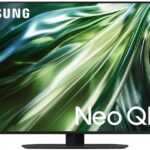 | $$ | Mini-LED | 2200+ nits | 144 Hz | HDR10, HDR10+, HLG | Tizen | 4x HDMI 2.1, VRR, FreeSync, 5ms input lag | Ultra-bright; excellent contrast; top-tier gaming support | No Dolby Vision; slight blooming in extreme tests | Flush mount, recycled materials |
| #2: TCL QM8 QLED 4K |  | $$ | Mini-LED | 2000+ nits | 120 Hz (240 Hz @1080p) | Dolby Vision, HDR10+, HLG | Google TV | 2x HDMI 2.1, VRR, Game Accelerator | Outstanding HDR; elite value; rich color | Aggressive motion smoothing; minor reflections | Metal stand with soundbar shelf |
| #3: Sony Bravia XR X95L |  | $$$$ | Mini-LED | 1800 nits | 120 Hz | Dolby Vision, HDR10, HLG | Google TV | 2x HDMI 2.1, PS5 Auto HDR, VRR | Unmatched processing; superb motion and detail | Expensive; high power draw | Reinforced chassis for wall mounting |
| #4: Hisense U8N ULED |  | $$ | Mini-LED | 1900 nits | 144 Hz | Dolby Vision IQ, HDR10+, HLG | Google TV | VRR, Game Mode Pro, <10ms lag | Extreme brightness; strong gaming; budget-friendly | Plastic feet; occasional gradient banding | Graphite cooling sheet |
| #5: Samsung Q80D QLED |  | $$$ | Full-Array | 1300 nits | 120 Hz | HDR10, HDR10+, HLG | Tizen | VRR, FreeSync Pro, 10ms input lag | Balanced feature set; good brightness; strong audio | No Dolby Vision; blooming visible off-angle | Central pedestal stand |
| #6: TCL Q7 QLED |  | $$ | Full-Array | 1000 nits | 120 Hz (240 Hz @1080p) | Dolby Vision, HDR10+, HLG | Google TV | 2x HDMI 2.1, Game Accelerator, VRR | High gaming value; solid contrast; U.S. glass | Minor blooming; plastic rear panel | Blade feet with adjustable height |
| #7: Hisense U7N ULED |  | $$ | Full-Array | 1300 nits | 144 Hz | Dolby Vision IQ, HDR10+, HLG | Google TV | VRR, 144Hz, Game Bar | Accurate color; warranty; low input lag | Reflective coating; weak speakers | Eco-friendly solder mask |
| #8: LG QNED90T |  | $$ | Mini-LED | 1500+ nits | 120 Hz | Dolby Vision, HDR10, HLG | webOS 24 | 4x HDMI 2.1, VRR, Game Optimizer | Excellent HDR tone mapping; wide color | Off-angle dimming; wide stand | NanoCell filtering with quantum dots |
| #9: Vizio MQX Quantum |  | $$ | Full-Array | 1000 nits | 120 Hz | Dolby Vision, HDR10+, HLG | SmartCast | 2x HDMI 2.1, VRR, Game Mode | Great price-to-performance; solid HDR | Reflections; occasional OS stutters | Filmmaker Mode support |
| #10: Samsung The Frame LS03D |  | $$$$ | Full-Array | 700+ nits | 120 Hz | HDR10, HDR10+, HLG | Tizen | 2x HDMI 2.1, 120Hz, VRR | Best design; matte screen; art mode | Lower brightness; fewer dimming zones | One Connect box + customizable bezels |

